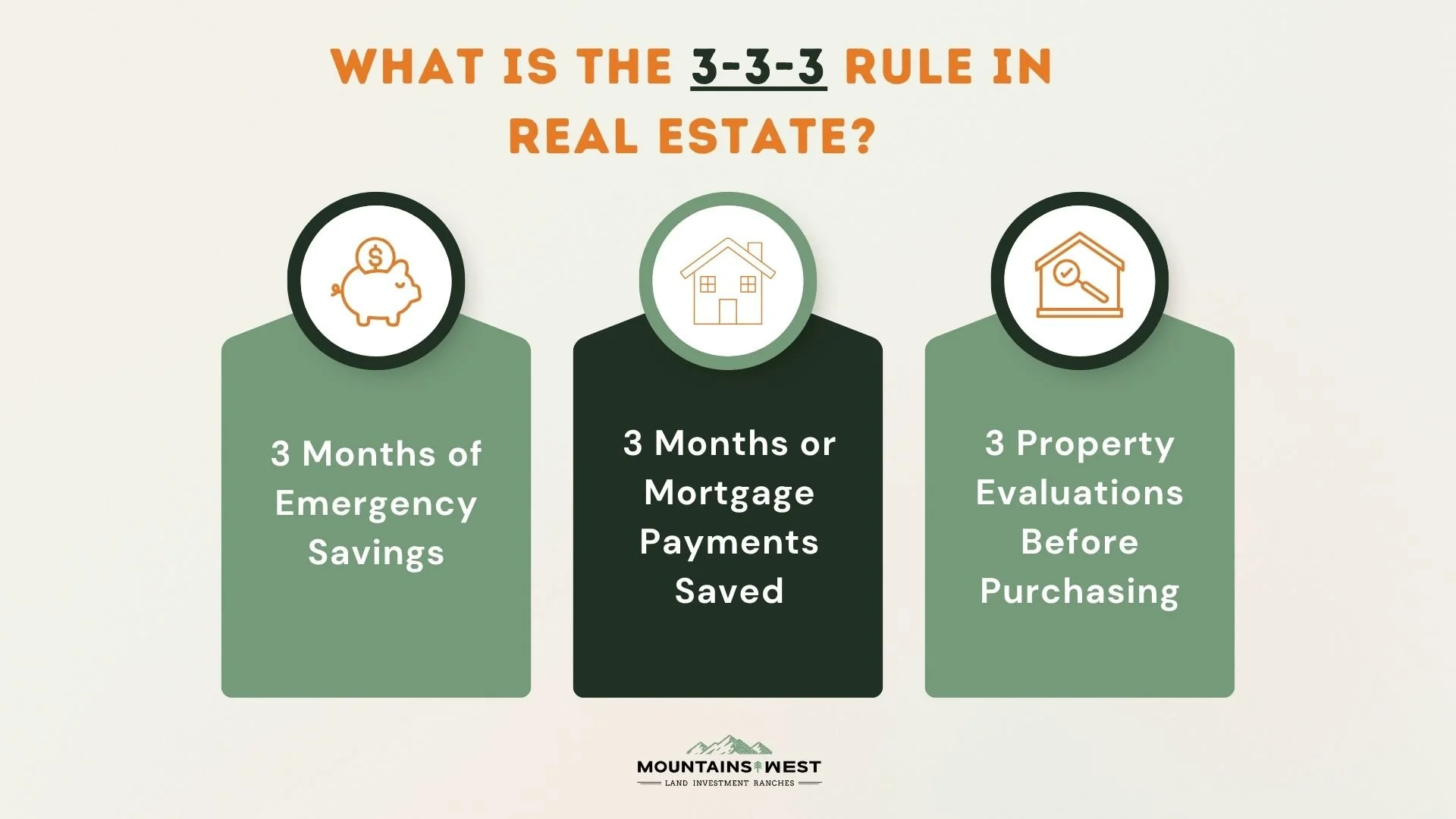What is the 3-3-3 Rule in Real Estate?
When it comes to buying land or investing in property, having a clear plan helps you avoid financial stress and make confident decisions. The 3-3-3 rule is a simple but powerful guideline that helps you assess readiness before making a real estate purchase. Whether you’re buying a home, a rental property, or rural land in Utah, this rule helps ensure that your finances, research, and long-term goals align before you commit. It’s a formula that keeps investors grounded, realistic, and prepared for the unexpected challenges that come with property ownership.
Understanding the 3-3-3 Rule
The 3-3-3 rule in real estate is designed to protect buyers from rushing into deals without enough financial or practical preparation. It’s built on three straightforward steps that help you assess your ability to buy and manage a property responsibly.
Each “three” in the rule represents a critical part of the buying process:
3 months of emergency savings
You should have at least three months’ worth of living expenses saved before purchasing a property. This ensures you can handle unexpected costs such as repairs, income loss, or delays without relying on credit or dipping into investment funds.3 months of mortgage payments saved
Having an extra three months of mortgage payments in reserve creates a cushion in case your income fluctuates or you experience a vacancy period on a rental property. It’s a safety net that prevents late payments or financial strain during slow months.3 property evaluations before purchasing
Always compare at least three different properties before making your decision. This gives you perspective on market prices, zoning benefits, terrain, and accessibility—especially if you’re looking at rural or off-grid properties. Evaluating multiple options helps you spot better opportunities and avoid overpaying.
By following this approach, you give yourself time to evaluate your options with a clear mind, not under pressure or emotion.
Why the 3-3-3 Rule Matters
Real estate is one of the most significant financial commitments most people make, and even small mistakes can cost thousands. The 3-3-3 rule keeps your decisions practical and helps you focus on long-term sustainability rather than short-term excitement. When you follow this method, you’re setting a foundation for financial health and peace of mind.
Some of the key benefits include:
Financial security: You’ll have money set aside to cover emergencies, property taxes, and unexpected maintenance.
Decision clarity: Comparing multiple options helps you avoid impulse buys or emotional decisions.
Risk reduction: You’re better equipped to handle market changes, job transitions, or project delays.
Investment longevity: With proper planning, your property becomes a stable, lasting investment rather than a short-term burden.
This rule is especially important for buyers entering the Utah market, where rural and recreational land purchases often involve unique factors like well access, power connections, or zoning research.
Applying the 3-3-3 Rule to Different Real Estate Goals
The beauty of the 3-3-3 rule is that it applies to nearly every kind of buyer. It’s flexible enough to guide first-time homeowners, seasoned investors, and off-grid land buyers alike. Depending on your goals, you can adapt the rule to fit your personal situation.
For First-Time Homebuyers
Buying your first home comes with new responsibilities and unexpected expenses. Having three months of savings gives you a comfortable financial buffer while you adjust to mortgage payments, property maintenance, and closing costs. It also helps you manage surprise expenses like appliance replacements, utility deposits, or minor repairs after move-in.
For Real Estate Investors
If you’re purchasing rental properties or land for resale, this rule helps you maintain consistent cash flow. Setting aside three months of mortgage payments ensures that you’re not dependent on immediate tenant income to stay afloat. It’s a safeguard against vacancies, repairs, or market downturns that can affect your return on investment.
For Rural or Recreational Land Buyers
Land purchases often come with additional variables—road access, power availability, septic systems, or development costs. Applying the 3-3-3 rule ensures that you have funds available to cover surveys, grading, fencing, or driveway installation. Reviewing at least three parcels helps you identify which property offers the best balance between price, accessibility, and long-term potential.
For Off-Grid or Homestead Buyers
When you’re planning to build off-grid, the 3-3-3 rule helps you pace your project phases wisely. Having savings for three months of materials, equipment, or utilities allows you to build sustainably without going into debt. It also ensures you have backup funds for essentials like solar batteries, water systems, or emergency repairs.
Common Mistakes to Avoid
Even with simple guidelines, many buyers overlook the financial details that matter most. Skipping small steps in the beginning can lead to large setbacks later, especially if you’re building, developing, or managing land long-term. The most common mistakes include:
Underestimating ongoing costs such as taxes, insurance, and utilities.
Focusing only on the property’s price instead of total long-term expenses.
Ignoring professional inspections, appraisals, or soil testing on rural land.
Forgetting to set aside funds for improvements or maintenance.
Being thorough early on helps you avoid setbacks and build a property investment that lasts for decades.
Final Thoughts
The 3-3-3 rule in real estate is more than a budgeting tip, it’s a foundation for smart property ownership. Whether you’re purchasing a home in the city or a private 10-acre parcel in Duchesne County, the same principles apply. Three months of savings, three months of mortgage reserves, and three property comparisons give you confidence and flexibility.
When you follow the 3-3-3 rule, you’re not just buying land, you’re building a long-term plan that protects your investment, your lifestyle, and your financial health.



